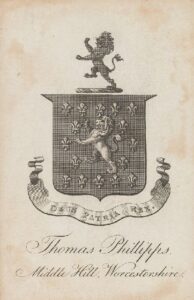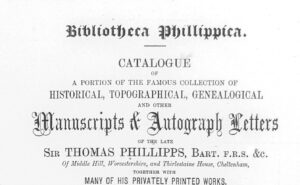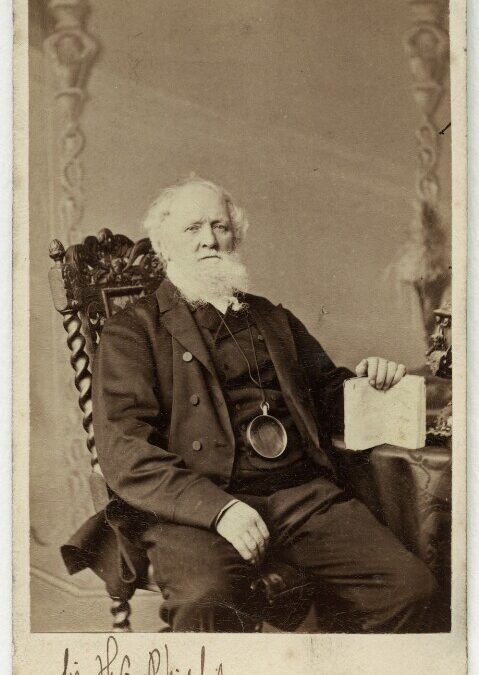At the start of a week examining the remarkable manuscript collection of Sir Thomas Phillipps, Dr Laura Cleaver of the Cultivate MSS project introduces the man, his collection and his legacy.
The church of St Eadburgha, in the Cotswolds village of Broadway, contains the following memorial tablet on its south wall, not far from the altar:
Here rests in Christ Sir Thomas Phillipps Baronet of Middle Hill in the County of Worcester and Thirlestaine House
This Tablet is placed by his daughter Katherine wife of Revd. J. E. A. Fenwick of Thirlestaine Housein the County of Gloucester born 2nd July 1792, died 6th February 1872. He was Deputy Lieutenant for the County of Worcester. A Fellow of the Royal and other Learned Societies and a zealous and renowned Antiquarian. He married first Harriet who lies buried here, daughter of Lieutenant General Sir Thomas Molyneux Bart and secondly Elizabeth daughter of Rev. W. Mansel eldest son of Sir William Mansel.
The tablet commemorates Sir Thomas Phillipps, one of the greatest collectors of medieval manuscripts and self-described ‘vello-maniac’, who lived a short distance from Broadway at his estate at Middle Hill.

Sir Thomas Phillipps, by Alexander George Tod albumen carte-de-visite, late 1860s-early 1870s NPG x12731 © National Portrait Gallery, London
In the course of his collecting career, Phillipps amassed over 60,000 manuscripts, including several thousand medieval books and historical documents of all kinds. He marked his ownership using a bookplate, stamp or sometimes just his name and a number. Phillipps’ actions played an important part in preserving these old books and documents and generating interest in them. However a collection on such a scale was difficult to manage and was to be a burdensome inheritance for his family.

Thomas Phillipps bookplate, Yale University, Beinecke Library MS Takamiya 50
The memorial tablet at Broadway conceals a messy family history. Sir Thomas’ lineage was, like those of both his wives, prestigious. However, he was the illegitimate son of another Thomas Phillipps, a wealthy textile manufacturer. The church at Broadway includes memorials to Phillipps’ father and grandfather, with the former bearing an inscription indicating that it was commissioned by Thomas Jr in 1820. These monuments set out a detailed family history, but omit to mention that Thomas Jr was not the biological son of Thomas Sr’s wife Mary.
Indeed, in their public piety the monuments at Broadway conceal deep family rifts. The church contains a memorial to Phillipps’ first wife Harriet (d. 1832), erected by her eldest daughter, also called Harriet, in 1875. Harriet Jr eloped after Phillipps refused permission for her to marry James Orchard Halliwell (the future biographer of Shakespeare) and the relationship was never restored. Unfortunately for Phillipps, because he had no son, under his father’s will the Middle Hill estate was to pass to Harriet’s heirs.

James Orchard Halliwell-Phillipps by Ernest Edwards, published by Lovell Reeve & Co
albumen print, published 1863 NPG Ax13838 © National Portrait Gallery, London.
As A. N. L. Munby documented, Phillipps’ relations with his youngest daughter Katherine and her husband (Rev. Fenwick) were also complicated. However, determined not to let Halliwell get his hands on his collection, Phillipps moved his manuscripts from Middle Hill to Thirlestaine House in Cheltenham, leaving that property in trust for Katherine and her son Thomas Fitzroy Fenwick. After that the property was to go to male heirs except those of the estranged daughter Harriet, with the stipulation that neither Harriet nor her husband should ever enter Thirlestaine House.
Much of the rest of Phillipps’ vast property was assigned to cousins, such that the income from the remains of the estate was completely inadequate to support the library entrusted to the Fenwicks. In 1885, therefore, Katherine secured a court judgement enabling the sale of manuscripts. Given the staggering size of Phillipps’ manuscript

For more information see A. N. L. Munby, The Family Affairs of Sir Thomas Phillipps (Cambridge, 1952).
collection, it is unsurprising that this process continued over more than six decades, providing regular excitement in Sotheby’s sale room.
Follow @cultivate_mss for more on Phillipps and his manuscripts.

